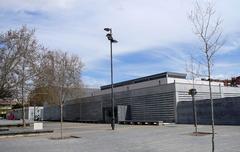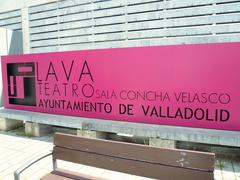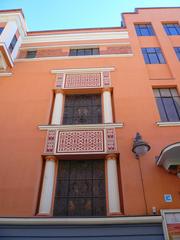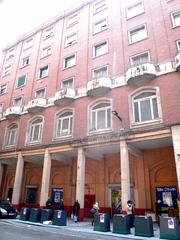Santa María La Real de Las Huelgas, Valladolid, Spain: Visiting Hours, Tickets & Historical Sites Guide
Date: 04/07/2025
Introduction
Nestled in the historic city of Valladolid, Spain, the Monastery of Santa María la Real de las Huelgas stands as a significant emblem of medieval monastic tradition, royal patronage, and layered artistic heritage. Founded in 1282 by Queen María de Molina, this Cistercian convent encapsulates centuries of religious devotion and architectural evolution. Its unique blend of Mudéjar, Gothic, Renaissance, and Baroque elements, together with its role as a royal retreat and burial place for noblewomen, makes it a compelling destination for history lovers, art enthusiasts, and cultural travelers. This guide provides detailed information on visiting hours, tickets, accessibility, architectural features, and practical travel tips for a rewarding experience at Santa María la Real de las Huelgas in Valladolid (Turismo Castilla y León, Spain.info, Megaconstrucciones).
Table of Contents
- Introduction
- Historical Overview
- Visiting Information
- Architectural and Artistic Highlights
- Frequently Asked Questions
- Visuals and Interactive Elements
- Conclusion and Visit Tips
- References
Historical Overview
Foundation and Early History
Santa María la Real de las Huelgas in Valladolid is among Spain’s most significant Cistercian nunneries, closely linked to the Castilian monarchy. The monastery was founded by Queen María de Molina, wife of King Sancho IV and regent for her son, Ferdinand IV. Its name, “Huelgas,” references the fallow lands granted for its foundation, while “Real” denotes its royal patronage (Wikipedia). The foundation in 1282 followed a devastating fire that destroyed the original monastic complex. Queen María de Molina ensured the community’s continuity by bestowing her former palace as their new home, establishing a tradition of close royal ties (Turismo Castilla y León).
Architectural Evolution
The current monastery primarily reflects significant 16th and 17th-century renovations. In 1579, a major reconstruction led by Juan Ribero y Rada and executed by Juan de Nates integrated remnants of the original palace, a city wall gate, and a 15th-century tower featuring a rose window with flamboyant Gothic tracery. The church, with its Latin cross plan and early Classical style, was pioneering for Valladolid and features chapels between the buttresses, reflecting evolving monastic needs (Turismo Castilla y León). The high altar, dating to the Baroque period, is a highlight, adorned with sculptures by Gregorio Fernández and crafted by Francisco Velázquez. The monastery’s artistic collection from the 17th century further elevates its cultural importance (Spain.info).
Religious and Social Significance
From its inception, the monastery served as a prestigious institution for Cistercian nuns and was a favored retreat and burial site for royal and noble women. While it did not reach the same prominence as its namesake in Burgos, its royal connections enabled it to commission significant architectural and artistic works. The community’s spiritual and economic influence was rooted in the Cistercian order’s dedication to austerity and self-sufficiency, shaping both the local landscape and Castilian society (Declausura.org).
Artistic Heritage and Preservation
Despite the destruction of its earliest structures in the 1282 fire, Santa María la Real de las Huelgas preserves valuable architectural features and artworks from multiple periods. The Mudéjar gateway, 15th-century tower, and Baroque high altar are particularly notable. The church’s artistic ensemble, especially the sculptures by Gregorio Fernández, exemplifies Spanish Baroque emotionality and technical mastery (Spain.info). Conservation efforts ensure these treasures remain accessible to future generations.
Visiting Information
Visiting Hours and Tickets
Public access to the monastery is limited due to its continued function as an enclosed convent. Visitors can enter the church during worship hours, typically on Sundays and religious holidays. There is no entrance fee, but donations are welcome to support preservation.
Typical Visiting Hours:
- Sundays: 10:00 AM – 12:00 PM
- Religious holidays: Times may vary; check official sources
The monastery itself is not open for general tours, and there are no ticketed guided tours inside. However, the church’s interior and artistic highlights can be experienced during mass or liturgical services. Exterior architectural elements may be included in broader historical walking tours of Valladolid.
Accessibility
The church is partially accessible for visitors with reduced mobility, though some areas have uneven floors typical of historic buildings. For up-to-date accessibility details, contact local tourist information (Valladolid Tourism Office).
Travel Tips and Nearby Attractions
- Location: Calle Estudios, 1, Valladolid, 47005, Spain
- Transport: Walkable from Valladolid’s city center; accessible via local buses. Parking is limited.
- Best Time: Early Sundays or holidays for a quieter, more contemplative visit.
- Nearby Sites: Casa Museo de Colón, Church of Santa María Magdalena, Valladolid Cathedral, National Sculpture Museum—all within walking distance.
- Photography: The Mudéjar gateway and 15th-century tower are ideal for exterior photos. Interior photography during services is generally not permitted.
Guided Tours and Special Events
While the monastery does not offer its own guided tours, local operators may include its exterior on walking tours of Valladolid. Occasional special events, such as festivals and concerts, may occur in the church—check tourism websites for updates.
Architectural and Artistic Highlights
Mudéjar Gate
The Mudéjar gate is the oldest surviving feature, exemplifying the fusion of Islamic and Christian art in medieval Castile. Its pointed horseshoe arch and intricate brickwork serve as a rare example of Mudéjar architecture in Valladolid (Wikipedia).
Church and Interior
Rebuilt after the 14th-century fire, the church combines late Gothic and early Renaissance forms. Its single nave, side chapels, and elevated choir reflect Cistercian simplicity and focus on spiritual contemplation (Megaconstrucciones).
Main Altarpiece (Retablo Mayor)
The 1613 Retablo Mayor, designed by Francisco de Praves and Francisco Velázquez, displays Baroque sculptures by Gregorio Fernández and paintings by Tomás de Prado. The altarpiece’s Marian iconography underlines the monastery’s dedication to the Virgin Mary.
Choir Stalls (Sillería del Coro)
The intricately carved wooden choir stalls, reserved for the nuns, demonstrate exceptional craftsmanship and remain central to the convent’s liturgical life.
Sepulchre of María de Molina
A focal point of the church, this 15th-century tomb features reliefs that exemplify late medieval Castilian funerary art and honors the monastery’s royal founder.
Mudéjar Plasterwork & Decorative Elements
Explore the 14th-century Mudéjar plasterwork with geometric and vegetal motifs, particularly in the palace rooms and the Capilla del Nacimiento (Megaconstrucciones).
Capilla del Nacimiento
This chapel boasts a decorative ceiling and a 1614 sculptural group by Gregorio Fernández, showcasing the emotional depth and technical skill of the Spanish Baroque.
Gothic Crucifix
The 14th-century crucifix in the church powerfully depicts Christ’s suffering, characteristic of the spiritual fervor of the era.
Frequently Asked Questions (FAQ)
Q: Can I buy tickets online for the Monastery of Santa María la Real de las Huelgas?
A: No, entry is free during worship hours; there are no online ticket sales.
Q: What are the visiting hours?
A: Sundays 10:00 AM–12:00 PM and on religious holidays. Times may vary; check before visiting.
Q: Is photography allowed inside?
A: Photography is generally not permitted during services.
Q: Is the site accessible for visitors with disabilities?
A: The church is partially accessible, but historic features may pose challenges. Contact for details.
Q: Are guided tours available?
A: No official tours inside, but local operators offer exterior tours.
Visuals and Interactive Elements
For visual inspiration and planning, visit official tourism websites for photo galleries and virtual tours of the monastery’s highlights—such as the Mudéjar gate, 15th-century tower, and Baroque altar.
Conclusion and Visit Tips
Santa María la Real de las Huelgas in Valladolid offers a rare glimpse into Spain’s medieval religious life, royal legacy, and artistic evolution. Its unique Mudéjar gateway, harmonious blend of historical styles, and active Cistercian community create an atmosphere of reverence and history. Though public access is limited, attending worship services allows visitors to experience its spiritual and artistic ambiance. Pair your visit with Valladolid’s other historical landmarks for a richer journey through the city’s heritage. For the latest visitor information, consult official sources and consider using the Audiala app for guided tours and updates (Turismo Castilla y León, Valladolid Tourism Office, Spain.info).
References and Further Reading
- Turismo Castilla y León: Monastery of Santa María la Real de las Huelgas
- Spain.info: Monastery of Huelgas Reales
- Megaconstrucciones: Abbey Santa María Real Huelgas Valladolid
- Wikipedia: Santa María la Real de las Huelgas (Valladolid)
- Valladolid Tourism Office
- Declausura.org: Monastery Santa Maria la Real de las Huelgas Valladolid




